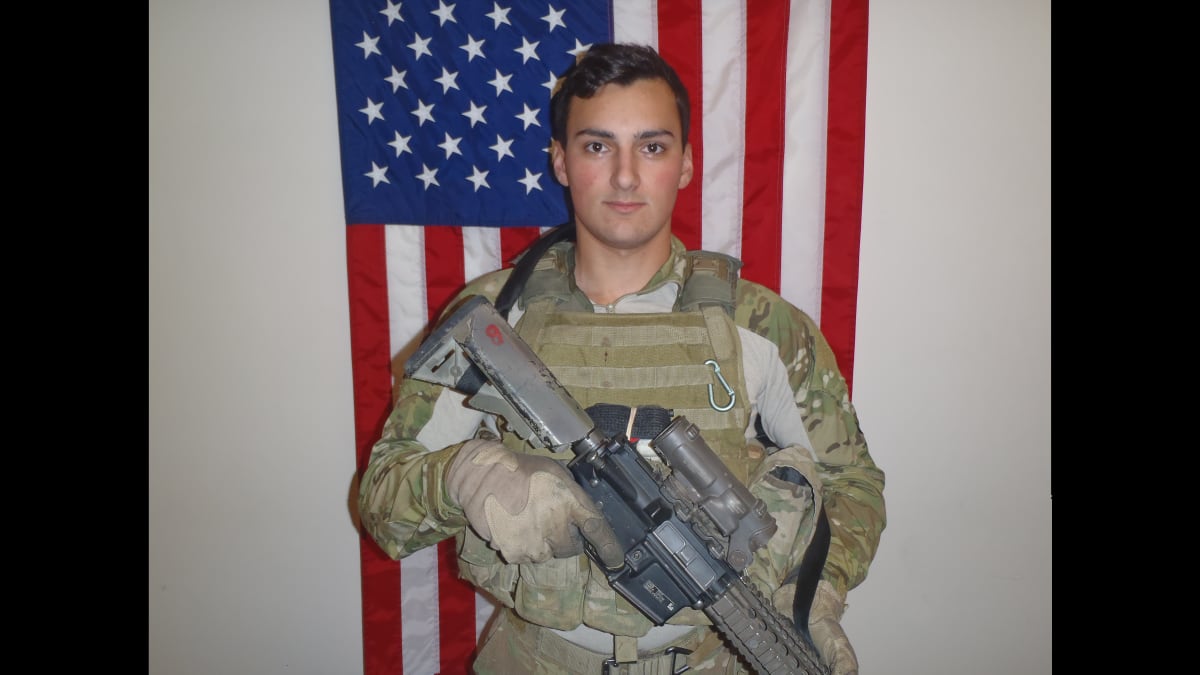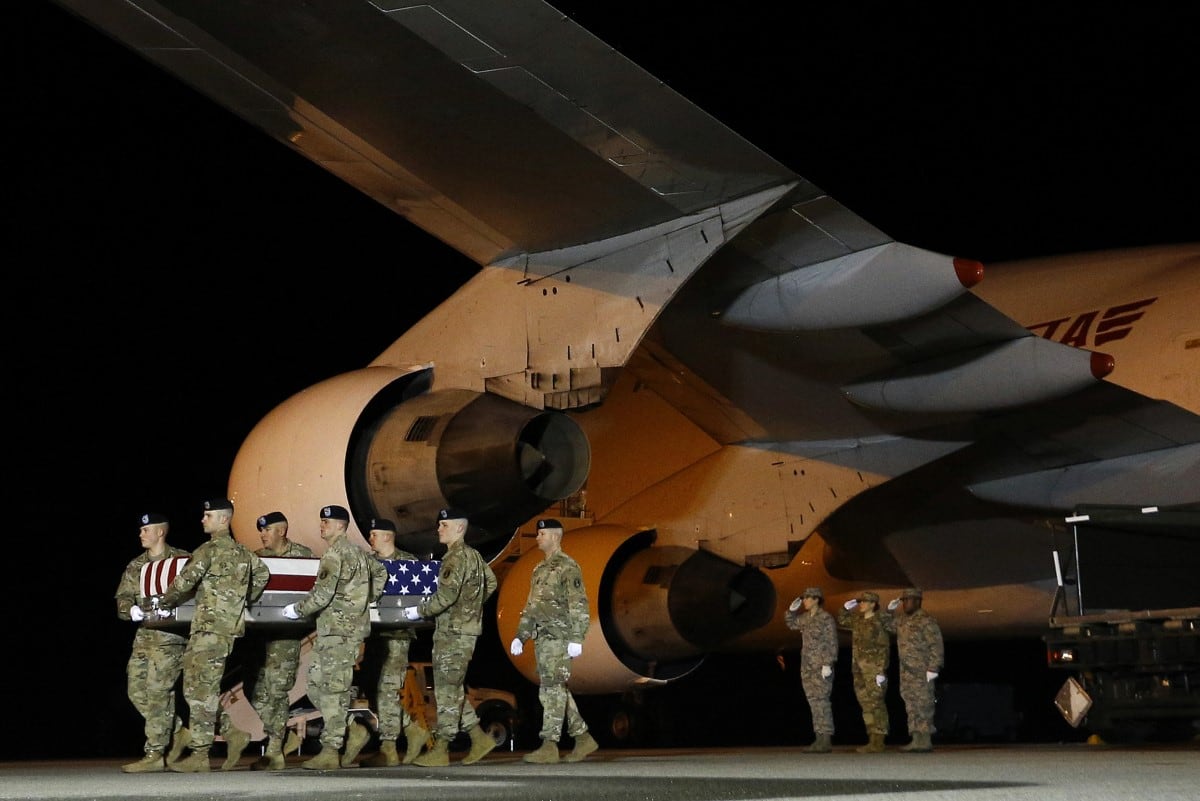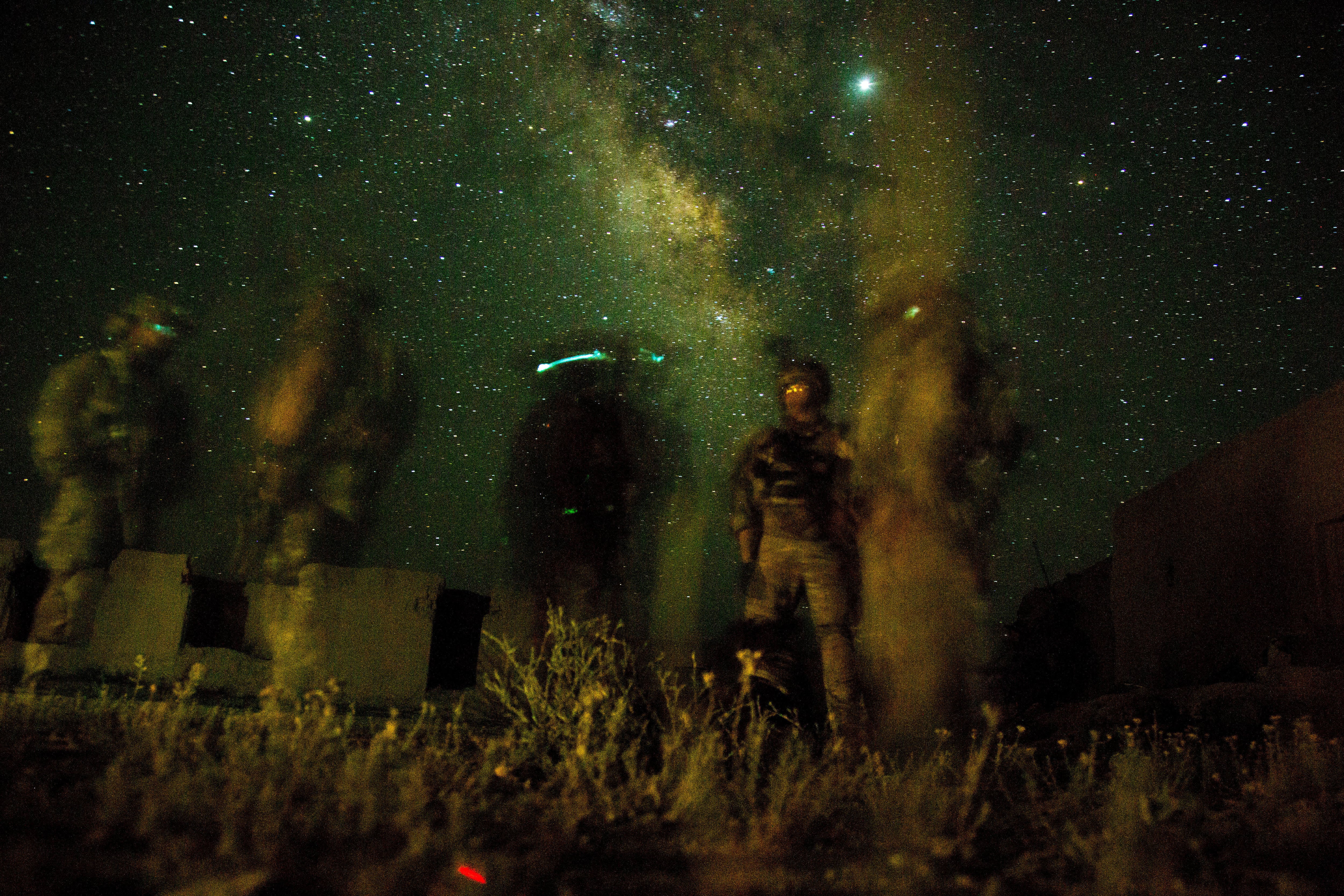In the final hours of Army Ranger Sgt. Leandro Jasso’s life, he breached a small building on the southwestern edge of Afghanistan and engaged five heavily barricaded al-Qaida fighters in close combat.
Two of the enemy fighters were killed inside, but three attempted to flee, only to be gunned down by the isolation element as they exited the compound.
Jasso’s element consolidated as they took stock of the roughly four-minute gunfight that yielded five enemy dead, recovered one M4 carbine with a thermal optic, three AK-47s, one PK machine gun and multiple chest racks with magazines and assorted ammunition.
The multi-purpose working dog that breached the building alongside them was mortally wounded in the exchange in the early morning hours of Nov. 24, 2018.
While clearing another building roughly an hour later, Jasso too would be mortally wounded by gunfire. This time, the shot came from a soldier with Ktah Khas, an obscure but lethal Afghan partner force that accompanies Rangers on direct action raids across the country, according to a copy of the internal investigation into his death. It was obtained by Army Times through a Freedom of Information Act request.
The investigation details a time-sensitive raid that included hasty mission planning to adjust the helicopter landing zone, fleeing enemy fighters that proved difficult to track and a strange scene in which the joint force tried to talk down a man in a large tree — even throwing a flash bang near him — only to find there was no man, just clothing items and a pair of shoes hanging below the branches.
The “person in the tree” momentarily distracted the team while they were clearing a second structure. An enemy fighter armed with an AK-47 emerged from a small room protruding from the building to spray the Rangers. In the ensuing gunfight, several Ktah Khas soldiers returned fire dangerously close to Jasso, who stood in a doorway approximately 10-12 feet from the enemy fighter.
Jasso was a member of 2nd Battalion, 75th Ranger Regiment, out of Joint Base Lewis–McChord, Washington. He was on his third deployment.
His final raid came at about 4 a.m. local time in Kash Rod district, Nimruz province, a place not often visited by U.S. forces these days.
Jasso, an Afghan soldier and another Ranger were all wounded within 53 seconds of each other, prompting an immediate casualty evacuation. He was pronounced dead less than half an hour after being airlifted to a treatment facility, likely Camp Dwyer in Helmand province.
Photos included in the investigation showed that a single 5.56 mm bullet was pulled from the left side plate pouch of Jasso’s body armor.
“There is no evidence that the KKA [Ktah Khas] soldier pre-meditatively or purposely killed Sgt. Jasso and there is no evidence specifically indicating which KKA soldier shot Sgt. Jasso,” the investigating officer wrote in his report. Each of the Ktah Khas soldiers denied shooting the Ranger.
None of Jasso’s actions on objective were found to be at fault in the death investigation.

The recommendations following the fratricide incident were redacted from the investigation. Army Special Operations Command did not say how, if at all, the fratricide changed the ways in which Ktah Khas and Rangers conduct missions together.
“The 75th Ranger Regiment has partnered with Afghan military forces for more than ten years and continue to refine our training and standard operating procedures based on lessons learned through the years," Lt. Col. Loren Bymer, a command official, told Army Times.
Prior to Jasso’s death, the Rangers and Ktah Khas soldiers had conducted five operations together with no friendly fire incidents.
During the Nov. 24 raid, the joint force was working a capture-kill mission against “known al-Qaida senior leader associates," the investigating officer wrote. It was approved by Maj. Gen. Albert Elton II, commander of Special Operations Joint Task Force–Afghanistan, before Central Command leadership and the secretary of defense were notified of the pending raid.
Fleeing fighters and Nimruz scarecrows
While the Rangers did their pre-mission checks, an aircraft in flight at the objective area noticed life stirring below. Four of the targeted individuals were spotted moving to a different building than originally planned, necessitating a hasty update to the original concept of operations, changing the insertion location and follow-on ground force actions to prioritize raiding two buildings roughly 750 meters apart.
After landing and surrounding the first building, Rangers and Ktah Khas soldiers began taking small arms fire from inside the compound. They returned suppressive fire before sending Jasso and his team inside to eliminate the five barricaded fighters.
After blowing in place the weapons cache, including the M4 carbine with thermal optic, the joint force then moved to the next set of buildings. At this point, a total of five unarmed adult males were spotted fleeing before the raiding party. Without weapons, they couldn’t be identified as enemy combatants. Four were eventually seen entering one building, while the fifth fled to a separate building not far south.
One of the fleeing males would cause a misunderstanding about the enemy’s exact location that partially contributed to the fratricide incident, the investigation determined.
At 3:58 a.m., a Ktah Khas soldier entered the first building and was immediately engaged by small arms fire and a grenade. He retreated to the building’s entrance and was pulled away by U.S. and Afghan personnel for medical treatment. The enemy fighters remained inside while an AC-130 gunship′s 105 mm guns were called in to “reduce the building,” killing the four fighters inside, the investigating officer wrote.
Further south, another cohort of Rangers and Ktah Khas chased the fifth fleeing male. Jasso and his team once more entered and cleared the first room of a roofless two-room building that measured 33 feet long and 14 feet wide. The building had a small protruding room, also with no roof.

Jasso’s team remained in the first room. At the same time, still roughly 4 a.m., a group of coalition forces on the outside of the building spotted what appeared to be a person in a large tree 30 feet to the east. They believed that the fifth fleeing male climbed the tree to hide and began using the Ktah Khas soldiers to yell at him to climb down and surrender. There was no reaction and so they threw a flash bang at the base of the tree to elicit a response.
Again, there was no movement and the team realized that what they thought was a person was in reality a set of clothing items to include shoes hanging below the branches.
Throughout this encounter, which lasted several minutes, Jasso and his team remained in the first room of the building.
As the team outside retraced their steps to Jasso’s location, one Ranger peered over the five-foot wall of the protruding, roofless room, and saw an enemy fighter pointing his AK-47 at those outside. The Ranger opened fire, as did the enemy fighter, kicking off another exchange of machine guns, small arms and one grenade. The enemy fire wounded a Ranger outside the building.
Just 15 seconds after the melee broke out, Jasso ordered his team out of the building to clear themselves from the engagement area. The troops with him exited the building. Jasso went last, but as he passed by the open door, a single round hit him. His teammates heard him fall, and ran back inside to drag him to cover.
In the span of a few minutes, the joint force had two wounded Rangers and one wounded Ktah Khas soldier on their hands, triggering a call for medical evacuation that arrived 18 minutes later. The joint force exfiltrated not long after.
In total, 10 enemy fighters were reported killed that night.
A lack of situational awareness
A fragmented M855 5.56 mm bullet, with a distinct green tip, was identified on Jasso’s body. Green-tipped 5.56 mm rounds were only carried by Ktah Khas soldiers that night, according to the investigation. Additionally, sensor footage from an overhead aircraft captured the muzzle flash from a Ktah Khas soldier directly pointed at Jasso the moment he dropped.
The investigating officer reported that the raid was adequately planned, rehearsed and led. The hasty changes did not negatively affect the operation, and the joint force was properly equipped for low-visibility raids. That night would have been a full moon, according to historical data, meaning ambient light would have been at its peak.
The factors that contributed to Jasso’s death ultimately come down to confusion over the exact location of the fleeing male fighter and a lack of positioning and situational awareness during a dynamic fight, according to the investigation.
The interdiction team, for instance, was “aware that the egressing male had entered [the building], but were not precisely aware where he moved after entering," the investigating officer wrote.
That roofless building had multiple entrances. Without completely clearing it, the team was able to see into most of the building, but the fleeing fighter remained hidden in the small cutout. Simultaneously, the team also misidentified what appeared to be a person in the tree directly east of the building. The visual inspection of the building coupled with the misidentified “person in the tree” sidetracked them, and they “did not place priority on clearing” the building, the investigating officer wrote.
A loss of situational awareness was also a factor during the engagement. The interdiction element focused fire on the protruding room, but at least one Ktah Khas soldier at the leading edge of the formation fired the shot that felled Jasso an estimated 10-12 feet south of the enemy fighter.

“In total, the footage shows what I assess as four separate KKA soldiers fire their weapons,” the investigating officer wrote. “Two prior to and two after Sgt. Jasso falling."
The investigator said he interviewed six of the seven Ktah Khas soldiers present during the engagement and each said “they never fired their weapon." One of the Afghans was not present for an interview.
The mission was also noteworthy for targeting al-Qaida, the original reason for the Afghan war but one that has slunk into relative obscurity compared to the fighting against the Taliban and now the Islamic State’s Afghan off-shoot.
“The U.S. doesn’t really know how many fighters al-Qaida has there," said Thomas Joscelyn, a prominent al-Qaida watcher and senior fellow at the Foundation for the Defense of Democracies think tank. “They’ve embedded themselves within the Taliban insurgency. ... But they’re not advertising what they’re doing. That’s very different from ISIS in that regard.”
Additionally, Afghan National Army Special Operations Command has been growing in recent years, sparking some experts to worry about a potential mass production of operators that dilutes the force’s overall capability. But that growth is mostly focused within the Afghan Commando Kandaks, and not Ktah Khas, according to Jonathan Schroden, an analyst at CNA who has directed assessments of Afghan security forces for the Pentagon.
“The expansion has mainly been moving the Mobile Strike Kandaks under ANASOC, expanding the Commandos and adding some combat support battalions,” Schroden said.
Ktah Khas, as a part of ANASOC, benefits from a significant cashflow from U.S. coffers, though. For fiscal year 2020, Afghan Special Security Forces received nearly $730 million in Pentagon funds, which helps them acquire and maintain equipment like AN/PEQ-15 infrared illuminators for aiming and AN/PVS-14 night vision devices.
Rangers today are often photographed with newer AN/PVS-15 night vision devices, though there’s no indication from the report that the generation gap in gear contributed to the fratricide incident.
Still, Afghan special operations forces have been photographed as recently as May 30 with older AN/PVS-7 night vision devices. A May 5 photo also appears to show an Afghan operator with a flashlight duct-taped to an M4 carbine rather than a proper IR laser, meaning it may be taking time for newer generation gear to trickle through the force.
U.S. officials with the ANASOC training and advising mission didn’t respond to a request for comment regarding the distribution of night vision devices to Afghan special operators. However, there’s usually a generation gap between the gear U.S. troops have and what their partner forces use for good reason.
“As you might imagine, there’s always a fear of the [Afghan forces] losing or outright selling what we give them, so that argues against giving them the latest tech," Schroden said. "Which means they most likely have the same tech that our guys had five to seven years ago.”
Kyle Rempfer was an editor and reporter who has covered combat operations, criminal cases, foreign military assistance and training accidents. Before entering journalism, Kyle served in U.S. Air Force Special Tactics and deployed in 2014 to Paktika Province, Afghanistan, and Baghdad, Iraq.





